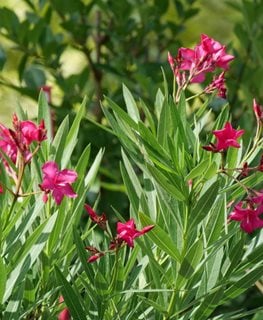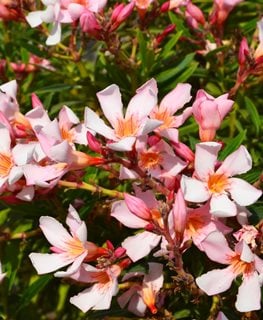A Guide to Growing Oleander Plants
Though toxic, you can still plant and enjoy this beautiful easy-care shrubA widely used landscape plant in warmer climates, oleander is grown for its carefree habit and attractive star-shaped flowers that bloom nearly year-round. Because of its beauty and tough nature, this evergreen shrub is commonly seen along highway medians and in public landscapes in places like California, Florida, and Texas.
Native to the Mediterranean region, oleander bush is also well-suited to residential landscapes, but caution must be taken due to its toxicity. Here’s how to safely add and care for oleander in your yard.
On this page: Basics | Planting | Care and Maintenance | Pictures | Design Ideas
On this page:
OLEANDER BASICS
Botanical name:
Nerium oleander
Zones:
8-11
Habit:
Upright bushy habit
Height/Spread:
4 to 20 feet tall, 3 to 15 feet wide
Light exposure:
Full sun
Growing conditions:
Oleander is adaptable to many challenging conditions including drought, heat, salty air and urban pollution. Plants can tolerate an occasional light frost.
Soil:
Oleander prefers average soil with good drainage and a neutral pH between 6.5-7.5. Plants are tolerant of poor soils.
Bloom period:
Year-round, with peak bloom in warmer months
Flowers:
Prolific clusters of funnel-shaped five-petaled flowers occur in hues of pink, white, red, coral, purple, or yellow. Some varieties are fragrant.
Foliage:
Slender olive-like green or variegated leaves 2 1/2 to 8 inches long grow on sturdy stems. The elegant foliage adds fine texture to the landscape.
Is oleander invasive?
Because of its extensive root system, oleander can be difficult to eradicate and can be invasive in some southern regions.
Is oleander deer-resistant?
The toxic properties of oleander protect it against certain enemies including deer.
Is oleander poisonous?
All parts of the oleander plant are highly toxic to humans and pets. See more on this below.
HOW TO PLANT OLEANDER
When to plant:
Spring or fall, when the weather is cooler
Where to plant:
Place in a site that receives full sun. Plants can tolerate some shade, but may become lanky and produce fewer flowers with less light. Avoid planting around curious children or pets.
How to plant:
Wear protective clothing and gloves to avoid direct contact with the plant. Loosen soil in planting area and amend with compost or other organic matter. Make sure soil is well-draining. Dig a hole 2 to 3 times wider and slightly deeper than the root ball. Remove plant from container and tease out roots if potbound. Place the plant in the hole so the top of the root ball is level with the surrounding soil. Fill in the hole with soil, tamp down gently to remove air pockets, and water thoroughly.
Spacing:
Space plants 4 to 12 feet apart, depending on the variety.
Planting oleander in containers:
Use a high quality all-purpose potting soil. Make sure containers have adequate drainage holes. Containers should be 10 to 14 inches wide for smaller varieties and 14 to 24 inches wide for larger cultivars.
OLEANDER CARE
Pruning oleander:
- Plants bloom on new wood.
- Deadhead spent oleander flowers to encourage new blooms.
- Wait until fall after peak bloom to prune.
- Remove dead and diseased branches and shape as needed.
To rejuvenate older or overgrown plants, cut 1/3 of the largest stems back to the ground. Cut remaining stems back by 1/4 of their height. In the following year, remove more of the large woody stems if necessary and trim back as needed.
Use protective gloves to prevent contact with the sap and wash hands well after pruning.
Fertilizing:
When planted in optimal conditions, oleander needs little or no supplemental fertilizer. If soil is poor and plants exhibit slow growth, pale leaves, or few flowers, apply an all-purpose granular fertilizer in early spring and again in early fall. Mulch with a layer of compost in spring. For container plants, apply an all-purpose granular fertilizer every 4 to 6 weeks.
Watering:
Water regularly and allow soil to dry out between waterings. Too much water can cause yellowing of the leaves or root rot. Containers will need more frequent watering.
Pests and diseases:
When given the right growing conditions, oleander will be more resistant to pests and diseases. Pests include aphids, mealybugs, red spider mite, scale, oleander caterpillar, false oleander scale, and glassy-winged sharpshooter. Diseases can include Sphaeropsis gall, oleander leaf scorch (a bacterial disease), leaf spot, sooty mold, and wood decay fungi.
OLEANDER VARIETIES
Oleander alternatives:
Good substitutes for oleander include bottlebrush (Callistemon citrinus), flannel bush (Fremontodendron californicum), and lemonade berry (Rhus integrifolia).
OLEANDER LANDSCAPING IDEAS
How to choose the right oleander:
- For borders and landscapes: Use medium and large varieties as hedging or screening, or naturalize in the landscape. Dwarf forms can be used as groundcovers, foundation plantings, in curbside strips or massed in the landscape.
- For slopes and hillsides: Mass along a bank or slope for a carefree display that will also help to stem erosion.
- For containers: Smaller specimens are suitable for containers. In climates colder than Zone 8, oleander can be grown in containers and overwintered indoors.
There are many ways to incorporate oleander into your landscape. Here’s how:
- Use a medium-sized variety to hide an eyesore such as an air conditioning unit, propane tank, or trash can storage area.
- Plant a smaller specimen in a container and place on a sunny deck, patio, or apartment balcony.
- Mass a small- to medium-sized variety along a slope for erosion control.
- Use a larger form as quick-growing screening to hide an unsightly view.
- Plant a curbside strip with smaller varieties that won’t obstruct views.
- Train a medium or larger variety into a small tree as a focal point in an island bed.
- Soften a home foundation or fence with a stand of a small to medium sized variety.
- Combine with other shrubs with similar needs that bloom at different times for continuous year-round color.
OLEANDER TOXICITY
Oleander contains multiple poisonous compounds and all parts of the plant are highly toxic to humans and pets. Ingesting even a small amount of the plant can result in serious injury or death.
The clear sticky sap can cause skin irritation or a rash on contact. Don’t burn discarded oleander branches, as it can release toxins into the air.
Keep dogs on a leash while out walking in areas where oleander is commonly planted and make sure they are not chewing on any plants. Symptoms can appear in as little as 30 minutes and be quite dramatic.
Contact your local Poison Control Center, physician or veterinarian immediately if you suspect your child or pet has come into contact with plants.
RELATED:
Shrubs 101
Best Flowering Shrubs for Season-Long Color
21 Low-Maintenance Plants
Common Poisonous Plants for Dogs & Cats










